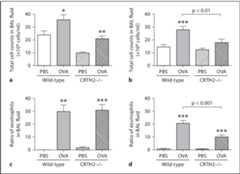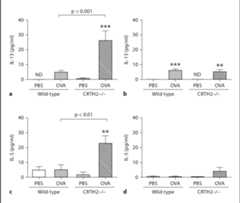DOI:10.1159/000327257 - Corpus ID: 34914925
Role of Prostaglandin D Receptor CRTH2 in Sustained Eosinophil Accumulation in the Airways of Mice with Chronic Asthma
@article{Kagawa2011RoleOP, title={Role of Prostaglandin D Receptor CRTH2 in Sustained Eosinophil Accumulation in the Airways of Mice with Chronic Asthma}, author={Shizuko Kagawa and Koichi Fukunaga and Tsuyoshi Oguma and Yusuke Suzuki and Tetsuya Shiomi and Koichi Sayama and Tokuhiro Kimura and Hiroyuki Hirai and Kin-ya Nagata and Masataka Nakamura and Koichiro Asano}, journal={International Archives of Allergy and Immunology}, year={2011}, volume={155}, pages={6 - 11}, url={https://api.semanticscholar.org/CorpusID:34914925}}- Shizuko KagawaK. FukunagaK. Asano
- Published inInternational Archives of…1 June 2011
- Biology, Medicine
CRTH2 that mediates PGD2 activity is essential for sustained eosinophilic inflammation in the airways, and its antagonists could exert an anti-inflammatory effect in chronic asthma.
19 Citations
The Prostaglandin D2 Receptor CRTH2 Contributes to Airway Hyperresponsiveness during Airway Inflammation Induced by Sensitization without an Adjuvant in Mice
- Satoshi HanzawaMakiko SugiuraYasunari Miyazaki
- 2024
Medicine, Biology
CRTH2 is responsible for the development of asthma responses in a mouse model of airway inflammation that features prominent involvement of both IgE and mast cells.
The Prostaglandin D2 Receptor CRTH2 Promotes IL-33–Induced ILC2 Accumulation in the Lung
- O. OyesolaC. DuqueElia D. Tait Wojno
- 2020
Medicine, Biology
It is shown that ILC2 accumulation in the murine lung in response to systemic IL-33 treatment was partially dependent on CRTH2, which suggests that CRTH 2-dependent effects lie downstream of IL- 33, directly affecting the migration of I LC2s into inflamed lung tissues.
Prostaglandin E2 Inhibits Group 2 Innate Lymphoid Cell Activation and Allergic Airway Inflammation Through E-Prostanoid 4-Cyclic Adenosine Monophosphate Signaling
It is demonstrated that prostaglandin E2 (PGE2) had a profound inhibitory effect on IL-33-induced ILC2 expansion and IL-5 andIL-13 production in vitro, revealing a novel function of PGE2 as a negative regulator of ILC1 activation and highlighting an endogenous counter-regulatory mechanism for the control of innate allergic inflammatory responses.
Activation of Th2 cells downregulates CRTh2 through an NFAT1 mediated mechanism
- Emily MacLean ScottL. SolomonC. DavidsonJ. StorieN. PalikheL. Cameron
- 2018
Biology, Medicine
Though prolonged activation led to NFAT1-mediated downregulation, CRTh2 was re-expressed when stimulus was removed suggesting this is a dynamic mechanism and may play a role in PGD2-CRTh2 mediated allergic inflammation.
Leptin Elicits In Vivo Eosinophil Migration and Activation: Key Role of Mast Cell-Derived PGD2
- N. AmorimGlaucia Souza-AlmeidaC. Bandeira‐Melo
- 2020
Medicine, Biology
The data show that leptin triggers eosinophilic inflammation in vivo via an indirect mechanism dependent on activation of resident mast cell secretory activity and mediation by TNFα, CCL5, and specially PGD2.
Inhibition of antigen-induced airway inflammation and hyperresponsiveness in guinea pigs by a selective antagonist of "chemoattractant receptor homologous molecule expressed on Th2 cells" (CRTH2).
- Mamoru TasakiMiki KobayashiY. Hirayama
- 2013
Medicine
Schizophyllum commune induces IL-17-mediated neutrophilic airway inflammation in OVA-induced asthma model mice
- Jun HanashiroY. MuraosaTakahito ToyotomeK. HiroseA. WatanabeK. Kamei
- 2019
Medicine, Biology
This study demonstrated that S. commune induces neutrophilic airway inflammation in OVA-induced asthma model mice, and IL-17A andIL-17F had central roles in this activity, and suggested that the fungus is a causative agent of asthma exacerbation.
The Regulatory Function of Eosinophils
- T. WenM. Rothenberg
- 2016
Biology, Medicine
Recent findings regarding novel roles of murine and human eosinophils are summarized and interactions with other hematopoietic cells are reviewed, focusing on interactions with non-immune cells.
Pulmonary Eosinophils at the Center of the Allergic Space-Time Continuum
- Sjoerd T. T. SchettersMartijn J. Schuijs
- 2021
Medicine, Biology
It is argued that immunological differences in eosinophils are a function of time and space as the allergic inflammatory response is initiated and resolved.
Prostaglandins and Their Receptors in Eosinophil Function and As Therapeutic Targets
- Miriam PeinhauptE. SturmA. Heinemann
- 2017
Medicine
The functions of PGD2, PGE2, and PGI2 and their receptors on eosinophils are focused on and their significance in allergic and non-allergic diseases are discussed and potential targets for drug intervention are summarized.
18 References
Prostaglandin D2 Plays an Essential Role in Chronic Allergic Inflammation of the Skin via CRTH2 Receptor1
- T. SatohR. MoroiMasataka Nakamura
- 2006
Biology, Medicine
In models of chronic contact hypersensitivity induced by repeated hapten application, CRTH2 deficiency resulted in a reduction by approximately half of skin responses and low levels of serum IgE production, which indicates that the PGD2-CRTH2 system plays a significant role in chronic allergic skin inflammation.
Prostaglandin D2-Induced Eosinophilic Airway Inflammation Is Mediated by CRTH2 Receptor
- Y. ShiraishiK. AsanoA. Ishizaka
- 2005
Biology, Medicine
Cyclooxygenase-2/Prostaglandin D2/CRTH2 Pathway Mediates Double-Stranded RNA-Induced Enhancement of Allergic Airway Inflammation1
- Y. ShiraishiK. AsanoA. Ishizaka
- 2008
Biology, Medicine
It is demonstrated that COX-2-dependent production of PGD2 followed by eosinophil recruitment into the airways via a CRTH2 receptor are the major pathogenetic factors responsible for the dsRNA-induced enhancement of airway inflammation and responsiveness.
Selective modulation of chemokinesis, degranulation, and apoptosis in eosinophils through the PGD2 receptors CRTH2 and DP.
- F. GervaisRani P. CruzG. O'neill
- 2001
Biology, Medicine
These data support the hypothesis that PGD(2) controls eosinophil functions through 2 pharmacologically distinct receptors with independent functions and suggest a role for CRTH2 in the modulation of eos inophil movement and in triggering the release of cytotoxic proteins.
Attenuation of allergic airway inflammation in IL‐4 deficient mice
- G. BrusselleJ. KipsH. Bluethmann
- 1994
Medicine, Biology
Results indicate that IL‐4 is a central mediator of allergic airway inflammation, regulating antigen‐induced eosinophil recruitment into the airways by a T cell dependent mechanism.
Pharmacological Blockade of the DP2 Receptor Inhibits Cigarette Smoke-Induced Inflammation, Mucus Cell Metaplasia, and Epithelial Hyperplasia in the Mouse Lung
- K. StebbinsA. BroadheadD. Lorrain
- 2010
Medicine
The data suggest that DP2 receptor antagonism may represent a novel therapy for COPD or other conditions characterized by neutrophil influx, mucus hypersecretion, and airway remodeling.
Prostaglandin D2 Selectively Induces Chemotaxis in T Helper Type 2 Cells, Eosinophils, and Basophils via Seven-Transmembrane Receptor Crth2
- H. HiraiKazuya TanakaK. Nagata
- 2001
Biology, Medicine
It is shown that a seven-transmembrane receptor, CRTH2, which is preferentially expressed in T helper type 2 (Th2) cells, eosinophils, and basophils in humans, serves as the novel receptor for PGD2.
Cutting Edge: Chemoattractant Receptor-Homologous Molecule Expressed on TH2 Cells Plays a Restricting Role on IL-5 Production and Eosinophil Recruitment
- É. ChevalierJ. StockBaiyong Li
- 2005
Biology, Medicine
PGs play key regulatory roles in inflammation and immunity. PGD2, released from mast cells and Th2 cells during allergic responses, has recently been shown to target a novel receptor, chemoattractant…
An Essential Role of Mast Cells in the Development of Airway Hyperresponsiveness in a Murine Asthma Model
- Tetsuto KobayashiT. MiuraK. Ishizaka
- 2000
Medicine, Biology
The results suggested that AHR could be developed by two distinct cellular mechanisms, one would go through mast cell activation and the other is IgE/mast cell independent but an eosinophil/IL-5-dependent mechanism.
Mast cells can promote the development of multiple features of chronic asthma in mice.
- Mang YuM. TsaiS. TamCarol D. JonesJ. ZehnderS. Galli
- 2006
Medicine, Biology
It is demonstrated that mast cells can contribute to the development of multiple features of chronic asthma in mice and both Fc Rgamma-dependent and F c RGamma-independent pathways of mast cell activation are identified as important for the expression of key features of this asthma model.
Related Papers
Showing 1 through 3 of 0 Related Papers



